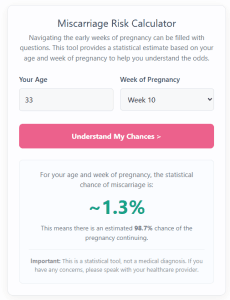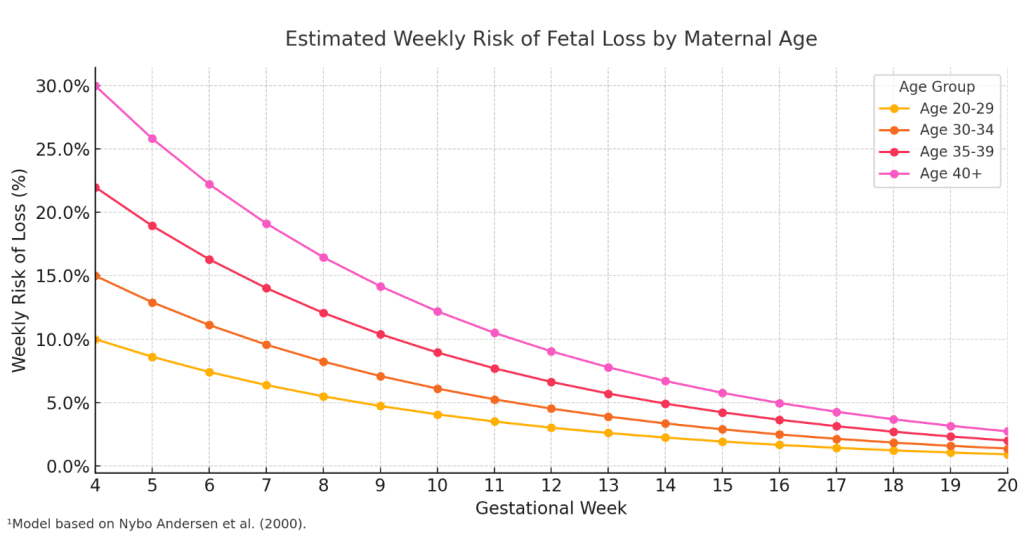Estimate miscarriage risk by week and day. Add age and, if you like, heartbeat, prior losses/births, and BMI for a more precise result.
Loss after 20 weeks is clinically defined as Stillbirth, not miscarriage. Please use our dedicated calculator for this stage.
Go to Stillbirth Risk Calculator →Based on Week Day :
Scope: This estimates the risk of loss from today up to 20 weeks. Loss after 20 weeks is medically classified as stillbirth.
Note: This tool uses statistical averages adjusted for age, history, and BMI. Every pregnancy is unique. Please consult your healthcare provider for medical advice.
How to use this calculator
- Enter your age: type your age in years.
- Enter your gestational age: add the week number and the day number (0–6), e.g., 8 weeks, 3 days.
- Optional advanced inputs: open Advanced options to add heartbeat status, prior miscarriages, prior live births, and BMI (via height and weight).
- Get your estimate: press Calculate to see the percent risk and the chance of continuing.
This tool is for education only and does not replace care from your clinician.

The Science Behind Miscarriage Risk
Most early miscarriages are due to chromosomal issues in the embryo, not anything a person did or did not do. The risk changes rapidly in early pregnancy and generally declines as gestational age increases.
- 1
Day-by-day baseline (what the calculator shows)
The estimate starts from a published day-by-day curve (about 3 to 20 weeks). For dates outside that range, the curve is smoothly extended to provide a reasonable estimate. Results are bounded between 0.1% and 80% to avoid over-certainty.
- 2
After a confirmed heartbeat
Once a fetal heartbeat is seen on ultrasound (often around 6–7 weeks), the ongoing risk is typically lower at the same gestational age. The day-by-day curve captures this general decline across the first trimester.
- 3
Optional factors
You can add prior miscarriages, prior live births, and BMI (from height and weight). These factors can nudge the estimate up or down based on population-level associations.
- 4
About age
Maternal age is an important population-level factor in miscarriage risk. The baseline day-by-day curve reflects average risk across ages; we’re exploring age-specific curves for future updates.
This calculator provides a statistical snapshot for a given day of pregnancy. It is for education only and does not replace care from your clinician.

¹The data model is based on findings from a landmark study on fetal loss: Nybo Andersen, et al. (2000). Maternal age and fetal loss: a population-based register-linkage study. BMJ, 320(7251), 1708–1712.
Frequently Asked Questions
What week has the highest miscarriage risk?
Risk is highest in the very early stages of pregnancy (chemical pregnancy). Clinically, most losses occur before 12 weeks, with a significant drop in risk typically observed after Week 8.
Does seeing a heartbeat lower the risk?
Yes, significantly. Studies show that once a viable fetal heartbeat is detected on ultrasound (usually after 6–7 weeks), the risk of miscarriage drops to below 5–10% for most age groups. Use the "Advanced Options" in our calculator to see this adjusted risk.
I am spotting. What should I do?
Light spotting can be normal in early pregnancy (occurring in up to 25% of healthy pregnancies). However, if you experience heavy bleeding, bright red blood, or cramping, contact your healthcare provider immediately.
How does this calculator estimate risk?
It combines daily probability data from large population studies with specific multipliers for your age, history, and ultrasound findings. See the Methodology section below for the exact data sources.
Methodology and sources
What this tool estimates
This tool estimates the approximate probability that a recognised intrauterine pregnancy will miscarry from the selected gestational day onward. It also shows a complementary chance of continuing figure, which is 100 percent minus the estimated risk. It does not estimate the chance of becoming pregnant again or the chance of later pregnancy outcomes.
Baseline risk by day
The model starts from published background miscarriage rates by gestational week and converts them into a day-by-day series from 3 weeks 0 days up to 20 weeks 6 days. The baseline risk generally decreases as gestation advances, reflecting large cohort data where the remaining risk of miscarriage falls as pregnancies progress.
Smoothing and interpolation
Weekly and multi-day values from the source tables are smoothed into a continuous curve so that each day has a defined risk value. Days between reported week points use simple interpolation, and days just outside the source range use gentle extrapolation from the nearest slope so that outputs remain defined but do not jump sharply.
Effect of seeing a heartbeat
When you select that a heartbeat has been seen on ultrasound, the tool applies a reduction to the baseline risk for that gestational day. This reflects prospective studies showing that, in asymptomatic women, the risk of miscarriage drops once a viable heartbeat is confirmed, especially after around 8 weeks. The result is still expressed as a risk from this point forward.
Adjustments applied
The baseline is then adjusted using simple, population-based multipliers:
- Previous miscarriages: The risk is increased in broad steps with the number of prior miscarriages (0 → ×1.0; 1 → ×1.3; 2 → ×1.5; 3 or more → ×2.0). These bands reflect higher recurrence risks in observational studies but are kept coarse for counselling.
- Previous live births: A modest protective factor is applied (0 → ×1.0; 1 → ×0.90; 2 → ×0.81; 3 or more → ×0.73), reflecting that having had uncomplicated live births is often associated with lower average miscarriage risk.
- Body mass index (optional): If height and weight are entered, BMI is calculated and a simple modifier is used. Underweight and higher BMI categories are given higher multipliers, based on literature linking extremes of BMI with higher miscarriage risk. If BMI is not entered, no weight-related adjustment is made.
- Bounds: The final value is capped within a practical range (for example, not lower than about 0.1 percent or higher than 80 percent) so that extreme combinations of answers do not produce unrealistic percentages.
Scope and limits
This calculator is a counselling aid built from population averages and broad risk groups. It does not include many important clinical details, such as bleeding, pain, specific ultrasound measurements (crown–rump length, heart rate, haematoma), genetic testing, assisted reproduction protocols, or other medical conditions. Actual risk for any individual pregnancy may be higher or lower than the estimate.
Disclaimer
This tool is for general education only and is not medical advice. It does not diagnose pregnancy problems or replace in-person assessment. Anyone with pain, bleeding, or other concerning symptoms in pregnancy should seek prompt care and follow local guidance and ultrasound findings from their clinician.
Sources
Key studies and guidelines that informed this model include:
- Avalos LA, Galindo C, Li DK. A systematic review to calculate background miscarriage rates using life table analysis. Birth Defects Research A, 2012. PubMed
- Tong S, Kaur A, Walker SP, et al. Miscarriage risk for asymptomatic women after a normal first-trimester prenatal visit. Obstetrics and Gynecology, 2008. PubMed
- Magnus MC, Wilcox AJ, Morken N-H, Weinberg CR, Håberg SE. Role of maternal age and pregnancy history in risk of miscarriage. BMJ, 2019. bmj.com
- NICE guideline NG126. Ectopic pregnancy and miscarriage: diagnosis and initial management. nice.org.uk
- American College of Obstetricians and Gynecologists. Early Pregnancy Loss (patient information). acog.org
Support if you have experienced a loss
Reading about miscarriage, stillbirth, or infant loss can be difficult. If you have experienced a loss, you do not have to use this calculator or read the statistics. You may find it more helpful to talk with your care team or a support organization.
In the United States, groups such as:
offer information and bereavement support. If you are elsewhere, your local health service or a pregnancy and baby loss charity may be able to guide you to support in your region.
Medical disclaimer
The information and calculators on this site are educational tools only. They provide statistical estimates based on published research and the details you enter.
They cannot diagnose, predict what will happen for you, or replace personalized advice from a licensed health care professional who knows your full history. Always talk with your doctor, midwife, or other qualified clinician before making decisions about your health, fertility, or pregnancy.
Never ignore, avoid, or delay seeking professional medical advice because of something you read here or a result you see in a calculator. If you think you may be having a medical emergency, call 911 in the United States or your local emergency number.
